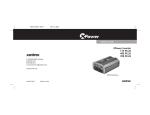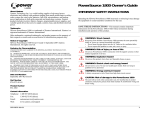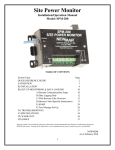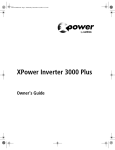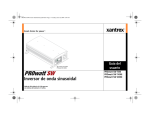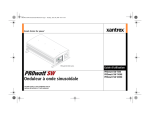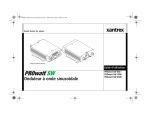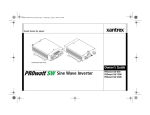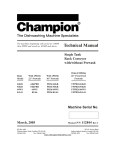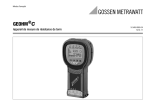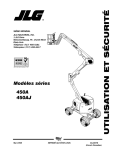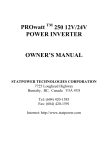Download Xantrex PROwatt 600 User's Manual
Transcript
PROwatt™ 600 Inverter Owner’s Guide Tel: 1-800-670-0707 Fax: 1-800-994-7828 Email: [email protected] Web: www.xantrex.com 445-0115-01-01 Made in China PROwatt 600 Inverter Owner’s Guide About Xantrex Xantrex Technology Inc. is a world-leading supplier of advanced power electronics and controls with products from 50 watt mobile units to 1 MW utilityscale systems for wind, solar, batteries, fuel cells, microturbines, and backup power applications in both grid-connected and stand-alone systems. Xantrex products include inverters, battery chargers, programmable power supplies, and variable speed drives that convert, supply, control, clean, and distribute electrical power. Trademarks PROwatt is a trademark of Xantrex International. Xantrex is a registered trademark of Xantrex Technology Inc. Other trademarks, registered trademarks, and product names are the property of their respective owners and are used herein for identification purposes only. Notice of Copyright PROwatt 600 Owner’s Guide © January 2001 Xantrex International. All rights reserved. Disclaimer While every precaution has been taken to ensure the accuracy of the contents of this guide, Xantrex International assumes no responsibility for errors or omissions. Note as well that specifications and product functionality may change without notice. Date and Revision January 2001, Revision 1 Part Number 445-0115-01-01 Contact Information Web: www.xantrex.com Email: [email protected] Phone: 1-800-670-0707 Fax: 1-800-994-7828 About This Guide Purpose The PROwatt 600 Owner’s Guide contains information that enables individuals to install, operate, and troubleshoot the PROwatt 600 Inverter. Scope The guide provides safety guidelines, detailed information for designing an installation, procedures for installing the inverter, as well as operating and troubleshooting information. It does not provide details about particular brands of batteries. You need to consult individual battery manufacturers for this information. Audience The guide is intended for anyone who needs to install and operate the PROwatt™ 600 Inverter. About This Guide Organization This guide has four chapters and four appendixes. Chapter 1, “Introduction”, outlines the main performance and safety features of the PROwatt 600 Inverter. Reading this chapter will give you a clear understanding of the inverter’s capabilities. Chapter 2, “Installation”, outlines the inverter’s main physical features. This information will give you a good orientation to the product before you install it. The chapter then goes on to explain how to plan and complete an effective installation. Chapter 3, “Operation”, provides information about turning on and operating the inverter. Details are provided about how to read the front panel indicators to monitor the system. The chapter also provides information about battery charging and routine maintenance. Chapter 4, “Troubleshooting”, explains how to identify and solve problems that can occur with the inverter. Appendix A, “Specifications”, provides the electrical and physical specifications. Appendix B, “Battery Types and Sizes”, provides background information about battery types as well as information that will allow you to calculate the size and number of batteries your system requires. Appendix C, “Alternators and Charging Systems”, describes charging system components and explains how to design a charging system for your installation. Appendix D,“Product and System Information” , contains the product’s warranty, explains how to return a product for service, and describes how to prepare for a call to Xantrex Customer Service. iv About This Guide Conventions Used The following conventions are used in this guide. WARNING Warnings identify conditions that could result in personal injury or loss of life and appear in this form. CAUTION Cautions identify conditions or practices that could result in damage to the PROwatt unit or to other equipment. Note: Notes describe additional information which may add to your understanding of how to use the inverter. Related Information You can find more information about Xantrex Technology Inc. as well as its products and services at www.xantrex.com v vi Important Safety Information WARNING Before installing and using your PROwatt™ 600 Inverter, read and save these safety instructions. General Precautions 1. Before installing and using the inverter, read all appropriate sections of this guide and any cautionary markings on the inverter and the batteries. 2. Do not operate the inverter if it has received a sharp blow, been dropped, or otherwise damaged. If the unit is damaged, see “Warranty” on page 42 and “Return Material Authorization Policy” on page 43. 3. Do not dismantle the inverter; it contains no user serviceable parts. Attempting to service the unit yourself could cause electrical shock or fire. Internal capacitors remain charged after all power is disconnected. See page 43 for instructions on obtaining service. 4. To reduce the risk of electrical shock, disconnect both AC and DC power from the inverter before working on any circuits connected to the inverter. Turning off the front panel On/Off will not reduce this risk. 5. Protect the inverter from rain, snow, spray, and bilge water. 6. To reduce the risk of overheating or fire, keep the ventilation openings clear, and do not install the inverter in a zero-clearance compartment. vii Explosive Gas Precautions Explosive Gas Precautions 1. Batteries generate explosive gases during normal operation. Be sure you follow all relevant instructions exactly before installing or using your inverter. 2. This equipment contains components which tend to produce arcs or sparks. To prevent fire or explosion, do not install the inverter in compartments containing batteries or flammable materials or in locations that require ignition-protected equipment. This includes any space containing gasoline-powered machinery, fuel tanks, as well as joints, fittings, or other connections between components of the fuel system. Precautions When Working With Batteries 1. Follow all instructions published by the battery manufacturer and the manufacturer of the equipment in which the battery is installed. 2. Make sure the area around the battery is well ventilated. 3. Never smoke or allow a spark or flame near the engine or battery. 4. Use caution to reduce the risk of dropping a metal tool on the battery. It could spark or short circuit the battery or other electrical parts and could cause an explosion. 5. Remove metal items like rings, bracelets, and watches when working with lead-acid batteries. These batteries produce a short-circuit current high enough to weld a ring or the like to metal, and thus cause a severe burn. 6. If you need to remove a battery, always remove the positive terminal from the battery first. Make sure all accessories are off so you don’t cause an arc. viii Precautions For Using Rechargeable Appliances Precautions For Using Rechargeable Appliances Most battery-operated equipment uses a separate charger or transformer that is plugged into an AC receptacle and produces a low voltage output. If the label on the AC adapter or charger states that the adapter or charger produces a low voltage AC or DC output (less than 30 volts), the PROwatt can power this charger or adapter safely. Some rechargers for small nickel-cadmium batteries can be damaged if connected to the PROwatt 600 Inverter. Do not use the following with the PROwatt 600 Inverter: • • Small battery-operated appliances like flashlights, razors, and night lights that can be plugged directly into an AC receptacle to recharge Chargers for battery packs used in hand power tools. These chargers display a warning label stating that dangerous voltages are present at the battery terminals AC Wiring Warning Do not connect the PROwatt 600 Inverter to AC distribution wiring. The PROwatt is designed to be connected directly to standard electrical and electronic equipment. Do not connect it to household or recreational vehicle AC distribution wiring. Do not connect it to any AC load circuit in which the neutral conductor is connected to ground (earth) or to the negative of the DC (battery) source. Doing so will destroy the unit. ix x Contents General Precautions - - - - - - - - - - - - - - - - - - - - - - - - - - - - - - - vii Explosive Gas Precautions - - - - - - - - - - - - - - - - - - - - - - - - - viii Precautions When Working With Batteries - - - - - - - - - - - - - - viii Precautions For Using Rechargeable Appliances - - - - - - - - - - - ix AC Wiring Warning- - - - - - - - - - - - - - - - - - - - - - - - - - - - - - - ix 1 Introduction Quality Power and Ease of Use - - - - - - - - - - - - - - - - - - - - - - - - 2 Comprehensive Protection - - - - - - - - - - - - - - - - - - - - - - - - - - - 2 2 Installation AC Wiring Warning- - - - - - - - - - - - - - - - - - - - - - - - - - - - - - - Safety Instructions - - - - - - - - - - - - - - - - - - - - - - - - - - - - - - - - PROwatt 600 Materials- - - - - - - - - - - - - - - - - - - - - - - - - - - - - Front Panel (AC End)- - - - - - - - - - - - - - - - - - - - - - - - - - - - - - Back Panel (DC End) - - - - - - - - - - - - - - - - - - - - - - - - - - - - - - Installation Tools and Materials - - - - - - - - - - - - - - - - - - - - - - - Tools - - - - - - - - - - - - - - - - - - - - - - - - - - - - - - - - - - - - - - - Materials - - - - - - - - - - - - - - - - - - - - - - - - - - - - - - - - - - - - - Planning Your Installation- - - - - - - - - - - - - - - - - - - - - - - - - - - Calculating Battery Requirements - - - - - - - - - - - - - - - - - - - - Choosing a Charging System - - - - - - - - - - - - - - - - - - - - - - - Choosing a Location - - - - - - - - - - - - - - - - - - - - - - - - - - - - - - Mounting the Inverter- - - - - - - - - - - - - - - - - - - - - - - - - - - - - - - 4 4 4 5 5 6 6 6 7 7 7 8 9 xi Contents Connecting the Chassis Ground - - - - - - - - - - - - - - - - - - - - - - - - 9 Grounding Locations - - - - - - - - - - - - - - - - - - - - - - - - - - - - - 10 Connecting DC Cables - - - - - - - - - - - - - - - - - - - - - - - - - - - - - 10 Cabling Guidelines - - - - - - - - - - - - - - - - - - - - - - - - - - - - - - 10 Cabling Procedure- - - - - - - - - - - - - - - - - - - - - - - - - - - - - - - 11 3 Operation Turning the Inverter On and Off- - - - - - - - - - - - - - - - - - - - - - Operating Several Loads at Once - - - - - - - - - - - - - - - - - - - - - Turning the Inverter Off Between Charges- - - - - - - - - - - - - - - Reading the Front Panel Indicators - - - - - - - - - - - - - - - - - - - - Green POWER LED - - - - - - - - - - - - - - - - - - - - - - - - - - - - Red FAULT LED - - - - - - - - - - - - - - - - - - - - - - - - - - - - - - Operating Limits - - - - - - - - - - - - - - - - - - - - - - - - - - - - - - - - Power Output - - - - - - - - - - - - - - - - - - - - - - - - - - - - - - - - - Input Voltage - - - - - - - - - - - - - - - - - - - - - - - - - - - - - - - - - Inverter Loads - - - - - - - - - - - - - - - - - - - - - - - - - - - - - - - - - - Problem Loads - - - - - - - - - - - - - - - - - - - - - - - - - - - - - - - - Trouble Loads - - - - - - - - - - - - - - - - - - - - - - - - - - - - - - - - Battery Charging Frequency - - - - - - - - - - - - - - - - - - - - - - - - Routine Maintenance - - - - - - - - - - - - - - - - - - - - - - - - - - - - - - 4 Troubleshooting Common Problems - - - - - - - - - - - - - - - - - - - - - - - - - - - - - - Buzz in Audio Equipment - - - - - - - - - - - - - - - - - - - - - - - - Television Reception - - - - - - - - - - - - - - - - - - - - - - - - - - - - Troubleshooting Reference - - - - - - - - - - - - - - - - - - - - - - - - - - A 16 16 16 17 17 17 18 18 18 19 19 19 20 20 22 22 22 23 Specifications Electrical Performance - - - - - - - - - - - - - - - - - - - - - - - - - - - - - 26 Physical - - - - - - - - - - - - - - - - - - - - - - - - - - - - - - - - - - - - - - - 26 B Battery Types and Sizes Battery Types - - - - - - - - - - - - - - - - - - - - - - - - - - - - - - - - - - - 28 xii Contents Automotive Starting Batteries - - - - - - - - - - - - - - - - - - - - - - Deep-Cycle Lead-Acid Batteries - - - - - - - - - - - - - - - - - - - - Battery Size - - - - - - - - - - - - - - - - - - - - - - - - - - - - - - - - - - - Estimating Battery Requirements - - - - - - - - - - - - - - - - - - - - - Battery Sizing Example - - - - - - - - - - - - - - - - - - - - - - - - - - - Battery Sizing Worksheet - - - - - - - - - - - - - - - - - - - - - - - - - - Two Batteries Connected In Parallel - - - - - - - - - - - - - - - - - - - Battery Tips - - - - - - - - - - - - - - - - - - - - - - - - - - - - - - - - - - - C Alternators and Charging Systems Charging System Requirements - - - - - - - - - - - - - - - - - - - - - - Charging With an Engine Alternator - - - - - - - - - - - - - - - - - - - Using Your Vehicle’s Standard Engine Alternator - - - - - - - - Using an Alternator Controller - - - - - - - - - - - - - - - - - - - - - Using a High-Output Alternator - - - - - - - - - - - - - - - - - - - - Charging From AC Power- - - - - - - - - - - - - - - - - - - - - - - - - - Charging From Alternative Energy Sources - - - - - - - - - - - - - - - D 28 29 29 31 32 33 34 35 38 38 38 39 39 39 40 Product and System Information Warranty - - - - - - - - - - - - - - - - - - - - - - - - - - - - - - - - - - - - - Return Material Authorization Policy - - - - - - - - - - - - - - - - - - Return Material Procedure - - - - - - - - - - - - - - - - - - - - - - - - - Information About Your System - - - - - - - - - - - - - - - - - - - - - - 42 43 43 45 Index - - - - - - - - - - - - - - - - - - - - - - - - - - - - - - - - - - 47 xiii xiv 1 Introduction Congratulations on your purchase of the PROwatt™ 600 Inverter! As part of the PROwatt Inverter family, the PROwatt 600 has been designed to give you quality power, ease of use, and outstanding reliability. Please take a few moments to read this chapter to familiarize yourself with the PROwatt 600’s main performance and protection features. Quality Power and Ease of Use Quality Power and Ease of Use The PROwatt 600 Inverter is a professional-quality, midrange inverter designed to handle a variety of household and commercial applications including large screen TVs, VCRs, computer systems, bread makers, blenders, fans, and small power tools. Superior features and rugged durability have been combined with extreme ease of use: • • • The unit is compact, light weight, and easy to install. The easy-to-read indicators on the front panel. Low standby battery demand means you don’t have to worry about draining your battery if you leave the inverter on for a few days. When the inverter is on but is not powering any loads, the draw on the battery is less than 300mA. Comprehensive Protection The PROwatt 600 Inverter comes equipped with numerous protection features to guarantee you safe and worry-free operation: Alerts you if the battery has become discharged to 10.7V or lower. Low battery alarm Protects the battery from becoming completely discharged if the battery voltage drops below 10V. Automatic low voltage shutdown feature High voltage shutdown feature Protects the inverter if the input voltage rises to 15V or more. Turns the inverter off if the temperature rises above an acceptable level. Over temperature shutdown feature 2 2 Installation Chapter 2 explains how to install the PROwatt 600 Inverter. Installing the PROwatt 600 is straightforward. Here’s a summary of the five main steps: • Plan the installation. • Choose a location. • Mount the inverter. • Connect the chassis ground. • Connect the DC cables. Remember: the better your planning, the better the performance you will receive from the PROwatt 600 Inverter. 3 AC Wiring Warning AC Wiring Warning WARNING Do not connect the PROwatt 600 Inverter to AC distribution wiring. The PROwatt is designed to be connected directly to standard electrical and electronic equipment. Do not connect it to household or recreational vehicle AC distribution wiring. Do not connect it to any AC load circuit in which the neutral conductor is connected to ground (earth) or to the negative of the DC (battery) source. Doing so will destroy the unit. Safety Instructions Before you install the PROwatt 600: • • Review the “Important Safety Information” on page vii. Read and follow all Warnings and Cautions in this chapter. PROwatt 600 Materials Your PROwatt 600 Inverter package includes: • 1 PROwatt 600 Inverter • 1 Owner’s Guide If either of these items is missing or is unsatisfactory in any way, please contact Xantrex Customer Service: Phone: 1-800-670-0707 Fax: 1-800-994-7828 Email: [email protected] As soon as you unpack your inverter, be sure to record the product information asked for on page 45. Then take a minute to familiarize yourself with the front and back panel features. 4 Front Panel (AC End) Front Panel (AC End) On/Off Switch PO WER POWER LED FAULT LED AC Power Receptacles Ventilation Openings FA ULT ON O UTPUT 115Vac 60H z O FF Figure 1 Front Panel (AC End) Back Panel (DC End) Negative and Positive DC Cabling Terminals Figure 2 Chassis Ground Screw Ventilation Openings Back Panel (DC End) 5 Installation Tools and Materials Installation Tools and Materials Tools ❐ Wire stripper ❐ Slot head screwdriver ❐ Wrench(es) for DC terminals ❐ Drill Materials ❐ 4 corrosion-resistant fasteners sized #10 or larger for mounting the inverter ❐ Copper DC cable sized appropriately for your installation ❐ Lugs and terminals for the DC cables as well as appropriate tools (e.g. crimping tool). (You may find it convenient to have the crimp connectors attached by the company that sells you the cable.) ❐ DC fuse(s) Bussman ANL-80 or a Gould type A3T80 Class T fuse with fuse holder ❐ Appropriately sized copper cable for the chassis ground ❐ Battery isolator ❐ Alternator controller* ❐ High-output alternator* * Consult Appendix B and Appendix C to determine whether you need these components. 6 Planning Your Installation Planning Your Installation Before doing anything else, you need to determine how you will be using your PROwatt 600 and on the basis of that, design a power system that will give the best performance. The more thorough your planning, the better your power needs will be met. In particular, you need to: • Calculate your battery requirements • Choose an effective charging system Calculating Battery Requirements Battery type and size strongly affect performance of the PROwatt 600. Therefore, you must identify the type of loads your inverter will be powering. Once you know how much power you will be using, you can determine how much battery capacity you need. Xantrex recommends that you purchase as much battery capacity as possible. Consult Appendix B “Battery Types and Sizes” on page 27 for a detailed explanation of how to determine the appropriate number and size of batteries for your installation. CAUTION The PROwatt 600 must only be connected to a battery that has a nominal output of 12 volts. It will not operate when connected to a 6 volt battery and will be damaged if connected to a 24 volt battery. Choosing a Charging System Your charging system must be appropriate for your inverter installation. This will ensure that power is available when you need it and that your batteries remain in top condition. Inadequate charging will degrade system performance, and the wrong type of charger will reduce battery life. Consult Appendix C “Alternators and Charging Systems” on page 37 for information that will explain how to design an effective charging system. 7 Choosing a Location Choosing a Location WARNING The PROwatt 600 contains components that tend to produce arcs or sparks. To prevent fire or explosion, do not install the PROwatt in compartments containing batteries or flammable materials or in locations that require ignition-protected equipment. WARNING To reduce the risk of fire, do not cover or obstruct the ventilation openings. Do not install the PROwatt 600 in a zero-clearance compartment. Overheating may result. The PROwatt 600 Inverter should only be installed in a location that meets these requirements: Dry Do not allow water or other liquids to drop or splash on the PROwatt 600. Cool Ambient air temperature should be between 32º F and 105º F (0º C and 40º C)—the cooler the better within this range. Ventilated Leave at least 2 inches (5 cm) clearance around the PROwatt 600 for air flow. Ensure that ventilation openings at the front and rear are not obstructed. Safe Do not install the inverter in the same compartment as batteries or in any compartment capable of storing flammable liquids like gasoline. Close to battery DC cables must be shorter than 4 feet (1.2 m) each. Longer AC wires are preferable to longer DC wires. Do not mount the inverter where it will be exposed to Protected from battery battery gases. These are very corrosive, and prolonged exposure will damage the inverter. gases 8 Mounting the Inverter Mounting the Inverter To mount the PROwatt 600 Inverter: 1. Turn off the inverter’s On/Off switch. 2. Select an appropriate mounting location and orientation. The PROwatt must be oriented in one of these two ways: • Horizontally on a vertical surface. (The ventilation openings must not point up or down.) • On or under a horizontal surface 3. Mark the positions of the four mounting screws, and pilot-drill the mounting holes. 4. Fasten the inverter using corrosion-resistant hardware sized #10 or larger. Connecting the Chassis Ground WARNING: Electrical Shock Hazard Never operate the PROwatt 600 without connecting the chassis to ground. Electrical shock hazard could result. This inverter does not provide isolation between the DC and AC circuits. Therefore the AC line and neutral are both “hot” relative to battery negative. The ground pins of the AC output receptacles are connected to the battery negative as is the chassis of the inverter. The PROwatt 600 has a screw terminal labeled CHASSIS GND on the rear panel as shown in Figure 1. This is to be used to connect the inverter’s chassis to the ground. To connect the chassis to ground, follow the guidelines below. 9 Connecting DC Cables Grounding Locations The chassis ground terminal must be connected to a grounding point, which varies depending on where you install the PROwatt 600. Follow the guidelines that correspond to your type of installation. Vehicle Connect the CHASSIS GND screw to the vehicle’s chassis using 8 AWG copper wire (preferably with green/ yellow insulation). Marine Connect the CHASSIS GND screw to the boat’s DC grounding bus or the engine’s negative bus using 6 AWG copper wire that has insulation rated at 90º C. Fixed Location (residential, for example). Connect the CHASSIS GND screw to your system’s DC grounding point using 6 AWG wire. The system’s grounding point will usually be the AC service entrance grounding point or a separate ground rod. For a solar PV (photovoltaic) installation, this is usually the same ground rod used to ground the PV array. Connecting DC Cables Proper cables and wiring are essential to effective operation of the PROwatt 600. Because the PROwatt 600 has a low voltage, high current input, low-resistance wiring between the battery and the inverter is essential to deliver the maximum amount of usable energy to your load. Cabling Guidelines Deviating from these guidelines will cause excessive voltage drop or melting of the cable and/or connectors. The inverter may also shut down or fail to operate some loads. • • 10 Make sure each cable between the inverter and the battery is no longer than 4 feet (1.2 m). Use 4 AWG copper (90º C insulation rating). Connecting DC Cables • Do not use aluminum. It has about 1/3 more resistance than copper cable of the same size, and it is difficult to make good, low-resistance connections to aluminum. Cabling Procedure Follow the procedure given below and consult Figure 3 and Figure 4 for details that are specific to your installation. FR O M ALTER N ATO R O R C HA R G ER ISO LATO R G RO U ND TO VE HIC LE C HA SS IS FU S E O R C IR C U IT BR EA KE R TO DC LO A DS DE E P-CY CLE AU XILIA R Y B ATTE RY FU SE O R C IR C U IT BR E AK ER VE HIC LE STA RTIN G B ATT ERY G RO U ND TO V EH IC LE C H A SS IS TO V EH IC LE G R O U N D TO V EH IC LE C H A SSIS PROwatt 600 Figure 3 Installation for Normal Loads 11 Connecting DC Cables FR O M A LT E R N ATO R OR CHARG ER IS O LATO R TO D C L O AD S FUSE OR C IR C U IT BR EA K E R D E E P -C Y C L E A U X ILIA R Y BAT T E RY V E H IC L E STA R TIN G B AT T E R Y G R O U N D TO V E H IC LE C H A S S IS D E E P -C Y C L E A U X ILIA R Y BAT T E RY G R O U N D TO V EH IC LE C H A SS IS TO V E H IC LE FUSE OR C IR C U IT B R E A K ER G R O U N D TO V EH IC L E C H A S S IS PROwatt 600 Figure 4 Installation for Heavy Loads Cabling Procedure To connect the DC cables: 1. Cut the cables to the correct length. 2. Strip the appropriate amount of insulation from one end of each cable and attach the connectors that will join the cables to the battery, battery isolator switch, or fuse block. The connectors you use must create a permanent, low-resistance connection. 12 Connecting DC Cables If you are using crimp connectors, use the tool recommended by the terminal manufacturer. Make sure no stray wires protrude from the terminal. (You can also have the crimp connectors attached by the company that sells you the cable.) 3. Strip about 1/2 inch (1.25cm) from the ends of the cables that will be connected to the inverter. 4. Install a fuse and fuse holder in the cable that will be used for the positive side of the DC circuit. The fuse must be as close to the battery as possible, must be rated for DC circuits, rated 80A max, and have a short-circuit interrupt rating that exceeds the short-circuit current available from the battery. Xantrex recommends a Bussman ANL-80 fuse or a Gould type A3T80 Class T fuse, or equivalent for installations requiring a “code fuse”. 5. Insert the stripped ends of the cables into the cabling terminals on the rear of the inverter and tighten the screws securely. The red terminal is positive (+); the black terminal is negative (–). See Figure 2. 6. Attach the connector on the negative cable to the negative battery terminal. Make a secure connection. Loose connectors cause excessive voltage drop and may cause overheated wires and melted insulation. CAUTION: Reverse Polarity Power connections to the PROwatt 600 must be positive to positive and negative to negative. A reverse polarity connection (positive to negative) will blow a fuse in the inverter and may cause permanent damage. Your warranty does not cover damage caused by a reverse polarity connection. 13 Connecting DC Cables 7. Before proceeding, make sure that the cable you have just installed connects the negative terminal of the inverter to the negative terminal of the battery. WARNING: Explosion or Fire Do not complete the next step if flammable fumes are present. Explosion or fire may result. Thoroughly ventilate the battery compartment before making this connection. 8. Connect the cable from the positive (red) terminal of the PROwatt 600 to the positive terminal of the battery. This is the last cable connection. A spark is normal when you make it. 9. If you have installed a battery selector switch, use it to select one of the batteries. 10. Turn on the inverter’s On/Off switch. 11. Check the inverter’s front panel. The POWER indicator should be on. If it is not, or if the FAULT indicator is on, check your battery and the connections to the inverter. 14 3 Operation Chapter 3 tells you how to operate the PROwatt 600 Inverter efficiently. Specifically, this chapter: • Explains how to turn the inverter on • Describes operating limits • Provides information about routine maintenance • Discusses optimal battery charging frequency 15 Turning the Inverter On and Off Turning the Inverter On and Off The On/Off switch on the front panel turns the control circuit in the PROwatt 600 on and off. To turn the inverter on or off: • Turn the On/Off switch or off. CAUTION The inverter’s On/Off switch does not disconnect power from the PROwatt. When the switch is Off, the inverter draws no current from the battery. Operating Several Loads at Once If you are going to operate several loads from the PROwatt 600, turn them on separately after you have turned the inverter on. This will ensure that the inverter does not have to deliver the starting current for all the loads at once. Turning the Inverter Off Between Charges When the switch is on but no power is being supplied to a load, the inverter draws less than 300 mA from the battery. This is a low current draw. It would take more than a week to discharge a 100 Ah battery at this current, so you don’t have to worry about excessive drain on your battery if you leave the inverter switched on for a few days. If you are not planning to recharge your battery within a week or so, turn the inverter off. 16 Reading the Front Panel Indicators Reading the Front Panel Indicators Green POWER LED The POWER LED is on when the inverter is connected to DC power and the inverter is switched On. Red FAULT LED The FAULT LED comes on for one of the following reasons: Condition Cause / Action Over Temperature Shutdown The PROwatt 600 has overheated and shut down. The inverter may have overheated because it was operated at power levels above its 600W continuous output rating or because it was installed in a location that does not allow it to dissipate heat properly. Turn the inverter off and then back on after it has cooled down. Note: To cool the inverter quickly, remove any loads, and leave the switch on to keep the fan running. Overload Shutdown A severe overload has caused the PROwatt 600 to shut down. Turn it off for 4–5 seconds, correct the fault condition, and turn it back on. Do not turn the inverter on again unless you have corrected the fault condition (removed the load or unplugged it). Low Voltage Shutdown The supply voltage (battery) has dropped below 10 V. High Voltage Shutdown The supply voltage (battery) has exceeded 15 V. See “Troubleshooting Reference” on page 23 for further details about the FAULT LED. 17 Operating Limits Operating Limits Power Output The PROwatt 600 Inverter will deliver 600W or 5A continuously. This wattage rating applies to resistive loads such as incandescent lights while the current rating applies to reactive loads such as motors. Input Voltage The input voltage limits are shown in the following table. Operating Condition Voltage Range Normal 10 V–15 V Peak Performance 12 V–14 V Comment Low Voltage Alarm At or below 10.7 V The audible low battery alarm sounds and FAULT indicator comes on. Low Voltage Shut Down Less than 10 V The inverter shuts down to protect the battery from being over-discharged. It will not restart unless the input voltage exceeds 10 V and the unit is manually reset. You manually reset the unit by turning it off for 4–5 seconds and then turning it back on. High Voltage Shut Down At or above 15 V The inverter shuts down to protect itself from excessive input voltage. The FAULT indicator comes on. Note: Although the PROwatt 600 incorporates over-voltage protection, it can still be damaged if input voltage exceeds 16 V. The unit will not restart unless the input voltage is less than 15 V and the unit is manually reset. You manually reset the unit by turning it off for 4–5 seconds and then turning it back on. 18 Inverter Loads Inverter Loads The PROwatt 600 will operate most AC loads within its power rating (600 watts / 5 amps). However, some appliances and equipment may be difficult to operate, and other appliances may actually be damaged if you try to operate them with the PROwatt 600. Please read “Problem Loads” and “Trouble Loads” carefully. Problem Loads S o m e in d u ctio n m o to rs u se d in fre ez ers, p u m p s, an d o th e r m o to r-o p era te d eq u ip m en t n eed h ig h su rg e cu rre n ts to start. T h e P R O w att 6 0 0 m ay n o t b e a b le to sta rt so m e o f th e se m o to rs e v e n th o u g h th eir rated c u rren t d raw is w ith in th e P R O w att’s lim its. T h e P R O w a tt 6 0 0 w ill n o rm a lly sta rt sin g le-p h ase in d u ctio n m o to rs ra te d at 1 /4 h o rse p o w e r o r less. Trouble Loads CAUTION Some equipment may be damaged by the PROwatt 600’s quasi-square wave output. Some appliances, including the types listed below, may be damaged if they are connected to the PROwatt 600: • Electronics that modulate RF (radio frequency) signals on the AC line will not work and may be damaged. • Speed controllers found in some fans, kitchen appliances, and other loads may be damaged. • Some rechargers for small nickel-cadmium batteries can be damaged if connected to the PROwatt 600. See “Precautions For Using Rechargeable Appliances” on page ix for further details. If you are unsure about powering any device with the PROwatt 600, contact the manufacturer of the device. 19 Battery Charging Frequency Battery Charging Frequency When possible, recharge your batteries when they are about 50% discharged or earlier. This will give you a much longer battery cycle life than recharging when the batteries are almost completely discharged. Routine Maintenance Minimal maintenance is required to keep your PROwatt 600 operating properly. Periodically you should: • • 20 Clean the exterior of the unit with a damp cloth to prevent the accumulation of dust and dirt Tighten the screws on the DC input terminals 4 Troubleshooting Chapter 4 will help you identify the source of most problems that can occur with the PROwatt 600 Inverter. If a problem occurs, please review this chapter before contacting Xantrex Customer Service. If you cannot solve a problem and need to contact Xantrex, record the information that is asked for in “Information About Your System” on page 4545. This will help our Customer Service Representatives give you better service. 21 Common Problems Common Problems WARNING Do not dismantle the PROwatt 600 Inverter. It does not contain any user-serviceable parts. Attempting to service the unit yourself could result in an electrical shock or burn. Buzz in Audio Equipment Some inexpensive stereo systems emit a buzzing noise from their loudspeakers when operated from the PROwatt 600. This occurs because the power supply in the audio system does not adequately filter the modified sine wave produced by the PROwatt. The only solution is to use a sound system that has a higher quality power supply. Television Reception When the PROwatt 600 is operating, it can interfere with television reception on some channels. If interference occurs, try the following: 1. Make sure the chassis ground screw on the rear of the PROwatt is solidly connected to the ground system of your vehicle, boat, or home. 2. Make sure that the television antenna provides an adequate (“snow-free”) signal and that you are using good quality cable between the antenna and the television. 3. Keep the cables between the battery and the PROwatt as short as possible and twist them together with two to three twists per foot. (This minimizes radiated interference from the cables.) 4. Move the television as far away from the PROwatt as possible. 5. Do not operate high power loads with the PROwatt while the television is on. 22 Troubleshooting Reference Troubleshooting Reference Problem Possible Cause Solution Low output voltage (96 Vac–104 Vac) You are using a voltmeter that cannot accurately read the RMS voltage of a modified sine wave. Overload Use a true RMS reading voltmeter. Load runs for a few seconds and then FAULT indicator lights. No output voltage, alarm Low input voltage sounding, and FAULT indicator on. No output voltage; The inverter is off. neither indicator on. No power to the inverter. Inverter fuse open. Reverse DC polarity. No output voltage and FAULT indicator is on. High input voltage. Low battery alarm stays Poor DC wiring; poor on; load ran for short battery condition. time. No output voltage; Thermal shutdown. FAULT indicator on; load exceeds 600 W/5 A output. Unit hot to touch. No output voltage and FAULT indicator is on. Short circuit. Very high power load. Reduce the load. Recharge battery; check connections and cable. Turn the inverter on. Check wiring to inverter. Have a qualified technician check and replace the fuse if necessary. Have a service technician check and replace the fuse, making sure to observe correct polarity. Make sure the PROwatt is connected to a 12 V battery. Check voltage regulation of the charging system. Use proper cable and make solid connections. Install a new battery. Allow the unit to cool off. Reduce the load if continuous operation is required. Improve ventilation. Make sure ventilation openings are not obstructed. Reduce ambient temperature. Check AC wiring for short circuit. Remove the load. 23 24 A Specifications Appendix A contains electrical and physical specifications for the PROwatt 600 Inverter. 25 Electrical Performance Electrical Performance Output power at 20º C ambient and 12 Vdc input: • Continuous power • Surge power 600 W 1200 W Output voltage 115 Vac RMS ±10% Output waveform Modified sine wave (quasisquare wave) Output frequency 60 Hz ±4 Hz Input voltage 10 Vdc–15 Vdc Low battery alarm Audible, 10.7 V Low battery shutdown 10 V High battery shutdown 15 V Optimum efficiency 90% No load current draw ≤0.3 A Physical Length 11” (28 cm) Width 6.25” (16 cm) Height 2.5” (6.5 cm) Weight 4.1lb. (2 kg) Specifications are subject to change without notice. 26 B Battery Types and Sizes The batteries you use strongly affect the performance of the PROwatt 600 Inverter. It is important to connect the inverter to the correct size and type of battery. The information in Appendix B will help you select, connect, and maintain batteries that are most appropriate for your application. 27 Battery Types Battery Types Automotive Starting Batteries Purpose The lead-acid battery you are most familiar with is probably the starting battery in your automobile. An automotive starting battery is designed to deliver a large amount of current for a short period of time (so it can start your engine). Only a small portion of the battery’s capacity is used to start the engine, and it is quickly recharged by the running engine. This type of battery is not designed for repeated cycles where the battery is almost completely discharged and then recharged. If it is used in this kind of deep discharge service, it will wear out rapidly. Light Loads If your installation uses relatively low power loads (that is, power consumption of 300 W or less) and relatively short operating times before recharging (one hour or less), you can connect the PROwatt 600 directly to the vehicle starting battery. See Figure 5. G R O U N D TO V E H IC LE C H A S S IS V E H IC LE S TA R TIN G B AT T E R Y FUSE OR C IR C U IT BR EA KER FROM A LTE R N ATO R GROUND TO V E H IC L E C H A S S IS PROwatt Figure 5 28 600 Battery Connection for Light Loads Battery Size Deep-Cycle Lead-Acid Batteries Purpose Deep-cycle lead-acid batteries are designed for deep discharge service where they will be repeatedly discharged and recharged. They are marketed for use in recreational vehicles, boats, and electric golf carts—so you may see them referred to as RV batteries, marine batteries, or golf cart batteries. Average and Heavier Loads For most applications of the PROwatt 600 Inverter, Xantrex recommends that you use one or more deep-cycle batteries that are separated from the vehicle’s starting battery by a battery isolator. A battery isolator is a solid-state electronic circuit that allows equipment to be operated from an auxiliary battery without danger of discharging the vehicle’s starting battery. During vehicle operation, the battery isolator automatically directs the charge from the alternator to the battery requiring the charge. Figure 6 shows a battery isolator. Battery isolators are available at marine and RV dealers and most auto parts stores. Battery Size CAUTION The PROwatt 600 must only be connected to batteries with a nominal output voltage of 12 volts. The PROwatt 600 will not operate from a 6 volt battery and will be damaged if connected to a 24 volt battery. Importance of Battery Size Battery size or capacity is as important as the battery type you use. 29 Battery Size Battery Capacity Standards A number of different standards are used to rate battery energy storage capacity. Automotive and marine starting batteries are normally rated in cranking amps. This is not a relevant rating for continuous loads like an inverter. Deepcycle batteries use a more suitable rating system, either “amp-hours” (“Ah”) or “reserve capacity” in minutes. Battery Reserve Capacity Battery reserve capacity is a measure of how long a battery can deliver a certain amount of current—usually 25 amps. For example, a battery with a reserve capacity of 180 minutes can deliver 25 amps for 180 minutes before it is completely discharged. Amp-hour capacity is a measure of how many amps a battery can deliver for a specified length of time—usually 20 hours. For example, a typical marine or RV battery rated for 100Ah can deliver 5 amps for 20 hours (5 A x 20 hours = 100 Ah). Amp-hour (Ah) Capacity Actual Battery Capacity Actual battery capacity decreases as discharge current increases. A battery rated at 100Ah which can deliver 5 A for 20 hours may deliver 20 A for only 4 hours, resulting in an actual capacity of 80 Ah. For this reason, it is difficult to compare rated Ah capacity with battery reserve capacity. For example, a battery with a reserve capacity of 180 minutes has the following calculated Ah capacity: 180 minutes ÷ 60 = 3 hours x 25 A = 75 Ah However its actual Ah rating will be closer to 100 because it is rated at the discharge current required to get 20 hours of operation (about 5 A). To calculate the battery capacity you require, read “Estimating Battery Requirements” on page 31 and “Battery Sizing Example” on page 32, and then complete the “Battery Sizing Worksheet” on page 33. 30 Estimating Battery Requirements Estimating Battery Requirements To determine the battery capacity you require: 1. Determine how many watts are consumed by each appliance that you will be operating from the PROwatt 600. You can normally find this on a label on the product. If only the current draw is given, multiply it by 115 to get the power consumption in watts. 2. Estimate how many hours each appliance will be operating each day. 3. Calculate the daily watt-hours needed for each appliance. 4. Add the total number of watt-hours needed for all the appliances and multiply it by the number of days between charges. 5. Divide the total watt-hours of AC load between charges by 10. This gives the battery Ah used between charges. 6. Double the total Ah used between charges to get the recommended battery size in Ah. See the battery sizing example that follows. 31 Battery Sizing Example Battery Sizing Example This example illustrates a typical calculation, assuming an opportunity to charge the batteries every three days. (B) Operating Time per Day Daily watt-hours needed for this appliance (= A x B) Appliance (A) Power Consumption TV & VCR 115 W 3 hours 345 Wh Sewing machine 150 W 1 hour 150 Wh Bread maker 600 W 1 1/2 hour 900 Wh Blender 300 W 15 min = 1/4 hour 75 Wh Total Daily watt-hours of AC load 1470 Wh x Number of Days between charges 3 = Total watt-hours of AC load between charges 4410 Wh Battery Ah used between charges (divide by 10) 441 Ah Recommended Battery Bank Size in Ah (multiply by 2) 882 Ah This example illustrates how quickly your battery needs can escalate. To reduce the required battery size, you can conserve energy by eliminating or reducing the use of some loads or re-charge more frequently. When sizing your battery, resist the temptation to skip the last step of this calculation (multiplying by 2). More capacity is better since you will have more reserve capacity, be better able to handle large loads and surge loads, and your battery won't be discharged as deeply. Battery life is directly dependent on how deeply the battery is discharged. The deeper the discharge, the shorter the battery life. 32 Battery Sizing Worksheet Battery Sizing Worksheet Use the following worksheet to calculate your battery needs. To ensure sufficient battery capacity, be generous when estimating the operating time per day for each of the loads you will run. Appliance (A) Power Consumption (B) Operating Time per day Daily watthours needed for this appliance (= A x B) W hours Wh W hours Wh W hours Wh W hours Wh W hours Wh W hours Wh W hours Wh W hours Wh Total Daily watt-hours of AC load Wh x Number of Days between charges = Total watt-hours of AC load between charges Wh Battery Ah used between charges (divide by 10) Ah Recommended Battery Bank Size in Ah (multiply by 2) Ah As your power requirements increase, you may need to use more than one battery to obtain sufficient capacity. Read “Two Batteries Connected In Parallel” to determine whether two batteries are appropriate for the applications you intend to power. 33 Two Batteries Connected In Parallel Two Batteries Connected In Parallel Two identical batteries can be connected positive (+) to positive (+) and negative (–) to negative (–) in a parallel system. A parallel system doubles capacity and maintains the voltage of a single battery. Figure 6 shows two batteries connected in parallel. CAUTION Do not make a parallel connection between batteries made by different manufacturers, different types of batteries, or batteries that have different Ah ratings. Decreased battery life and improper charging will result. Do not connect an old battery to a new one. FR O M ALT ER N ATO R OR CHARGER IS O LATO R TO D C L O AD S FUSE OR C IR C U IT BR EA KE R D EEP -C Y C L E AU XIL IAR Y BAT TE R Y V E H IC L E STA RT IN G B AT T ER Y G R O U N D TO VE H IC LE C H ASS IS D EEP -C Y C L E AU XIL IAR Y BAT TE R Y G R O U N D TO VEH IC L E C H A SS IS TO VE H IC L E FU SE O R C IR C U IT B R E AKER G R O U N D TO VEH IC LE C H ASS IS PROwatt Figure 6 34 600 Two Batteries Connected in Parallel Battery Tips Battery Tips WARNING Review “Precautions When Working With Batteries” on page viii before you work with the batteries in your system. Lead-acid batteries may emit hydrogen, oxygen, and sulfuric acid fumes when recharging. To reduce the risk of explosion: Explosive/Corrosive Gases • Vent the battery compartment to prevent the accumulation of gases. • Do not install electronic or electrical equipment in the battery compartment. • Do not smoke or use an open flame when working around batteries. Temperature Sensitivity The capacity of lead-acid batteries is temperature sensitive. Battery capacity is rated at 77º F (25º C). At 0º F (–20º C), the Ah capacity is about half the rated capacity. Temperature should be considered when you design your system. Low Temperatures If extremely low temperatures are expected where the inverter is going to be located, you should consider a heated equipment room. If the system is located in an unheated space, an insulated battery enclosure is recommended. High Temperatures The batteries should also be protected from high temperatures. These can be caused by high ambient temperatures, solar heating of the battery enclosure, or heat released by a nearby engine or generator. High battery temperature results in short battery life and should be avoided by ventilating the enclosure and reducing the external heat source by shading and insulation. 35 Battery Tips Do not leave batteries in a discharged state for more than a day or two. They will undergo a chemical process (sulfation) that can permanently damage the battery. As well, batteries self-discharge over a period of three to six months, so they should be recharged periodically even if they are not being used. Discharged Batteries Electrolyte Level If your batteries are not the “maintenancefree” type, check the electrolyte level at least once a month. Excessive fluid loss is a sign of overcharging. Replenish the electrolyte using distilled water only. Connections to battery posts must be made with permanent connectors that provide a reliable, lowresistance connection. Do not use alligator clips. Clean the connections regularly and prevent corrosion by using a protective spray coating or vaseline. Battery Connections You can measure battery state of charge with a hydrometer or, more easily, with a voltmeter. Use a digital voltmeter than can display tenths or hundredths of a volt when measuring 10 to 30 volts. Make your measurements when the battery has not been charged or discharged for several hours. For a deep-cycle battery at 77º F (25º C), use the following table: Battery State of Charge 36 Battery Voltage State of Charge 12.7–13.0 100% 12.5–12.6 80% 12.3–12.4 60% 12.1–12.2 40% 11.9–12.0 20% C Alternators and Charging Systems A good charging system is important for the health of your batteries. Poor recharging methods can quickly damage them. Appendix C provides guidelines for recharging batteries from an alternator, from AC power, and from alternate energy sources. 37 Charging System Requirements Charging System Requirements Your charging system should be capable of delivering a charging current equal to 10–25% of the amp-hour capacity of your battery. For example, if you have a 200 Ah battery, the charging system should be able to deliver 50 amps. The charging system must also be able to charge each 12 volt battery up to approximately 14.4 V and then drop back to a “float” voltage of 13.5–14 V (or shut off). CAUTION Never operate the PROwatt 600 directly from an alternator. To work properly the PROwatt must be connected to a battery or a well-regulated, highcurrent DC power supply. Charging With an Engine Alternator The following information will let you determine whether your vehicle’s standard alternator will be adequate by itself, whether you should install an alternator controller, or whether you need a high-output alternator. Using Your Vehicle’s Standard Engine Alternator A typical engine alternator (12 volts) may not be able to meet these requirements if your system uses large capacity batteries. Alternators are typically rated for the current they can deliver when they are cold. In use, alternators heat up, and their output current capability drops by as much as 25%. Therefore, standard alternators with ratings of 40–105 A will only deliver a maximum of 30–80 A in actual use and will deliver even less as battery voltage rises. Many alternators cannot produce more than 13.6 V when they are hot. As a result, a standard alternator may not be able to charge a large battery quickly and completely. Two solutions are to install an alternator controller or to install a high-output alternator. 38 Charging From AC Power Using an Alternator Controller If your regular alternator is inadequate by itself, you can install an alternator controller that will bypass the voltage regulator and boost the alternator’s output voltage during charging. This will increase the alternator’s charging rate at higher battery voltages and ensure more rapid and complete charging. Alternator controllers are available from marine product dealers. Using a High-Output Alternator Heavy-duty alternators rated from 100–140A can replace standard alternators and produce the higher current and voltage required to charge multiple battery systems. They are available from RV and marine dealers as well as auto parts suppliers. Charging From AC Power When recharging from AC power, use a good quality marine battery charger or RV converter that meets the requirements outlined in “Charging System Requirements” on page 38. For information about battery chargers manufactured by Xantrex, see the Xantrex web site at www.xantrex.com Do not use chargers intended for occasional recharging of automotive starting batteries. These chargers are not intended for continuous use. 39 Charging From Alternative Energy Sources Charging From Alternative Energy Sources Your batteries can also be recharged from alternative energy sources such as solar panels, wind, or hydro systems. Make sure you use the appropriate battery charge controller for your particular energy source. CAUTION N ever op erate th e P R O w att 600 Inverter directly fro m an en erg y source su ch as a so lar panel. T h e P R O w att m u st be co n n ected to a battery or a w ell-regulated, h ighcu rren t D C p o w er su p p ly to w o rk p ro p erly. 40 D Product and System Information Appendix D contains the warranty for your PROwatt 600 Inverter as well as instructions for returning the product for servicing. Appendix D also has a place where you can record information about your system in case you need to contact Customer Service. 41 Warranty Warranty What does this warranty cover? Xantrex manufactures its products from parts and components that are new or equivalent to new, in accordance with industry-standard practices. This warranty covers any defects in workmanship or materials. How long does the coverage last? This warranty lasts for twelve months from the date of purchase. Implied warranties of merchantability and fitness for a particular purpose are limited to twelve months from the date of purchase. Some jurisdictions do not allow limitations on how long an implied warranty lasts, so the above limitation may not apply to you. What does this warranty not cover? This warranty will not apply where the product has been misused, neglected, improperly installed, physically damaged or altered, either internally or externally, or damaged from improper use or use in an unsuitable environment. Xantrex does not warrant uninterrupted operation of its products. Xantrex shall not be liable for damages, whether direct, incidental, special, or consequential, or economic loss even though caused by the negligence or fault of Xantrex. Some jurisdictions do not allow the exclusion or limitation of incidental or consequential damages, so the above limitation or exclusion may not apply to you. What will Xantrex do? Xantrex will, at its option, repair or replace the defective product free of charge. Xantrex will, at its own option, use new and/or reconditioned parts made by various manufacturers in performing warranty repair and building replacement products. If Xantrex repairs or replaces a product, its warranty term is not extended. Xantrex owns all parts removed from repaired products. To qualify for the warranty, dated proof of purchase must be provided and the product must not be disassembled or modified without prior authorization by Xantrex. If your product requires warranty service, please return it to the place of purchase along with a copy of your How do you get service? 42 Return Material Authorization Policy dated proof of purchase. If you are unable to contact your merchant, or the merchant is unable to provide service, contact Xantrex directly at: Phone: Fax: Email: 1-800-670-0707 1-800-994-7828 [email protected] Return Material Authorization Policy You must obtain a Return Material Authorization (RMA) number from Xantrex before returning a product directly to Xantrex. Products returned without an RMA number or shipped collect will be refused. When you contact Xantrex to obtain service, be prepared to supply the serial number of your product and its date of purchase as well as information about the installation and use of the unit. Record this information in “Information About Your System” on page 45 of this guide. Return Material Procedure If you are returning a product from the USA or Canada, follow this procedure: 1. Obtain an RMA number and a shipping address from Xantrex. 2. Package the unit safely, preferably using the original box and packing materials. Include the following: • The RMA number • A copy of your dated proof of purchase • A return address where the repaired unit can be shipped • A contact telephone number • A brief description of the problem 3. Ship the unit freight prepaid to the address provided in step 1. Collect shipments will be refused. 43 Return Material Procedure This warranty gives you specific legal rights, and you may also have other rights which vary from jurisdiction to jurisdiction. How do other laws apply? When used herein “implied warranties of merchantability and fitness for a particular purpose” includes all warranties and conditions, express or implied, statutory or otherwise, including without limitation implied warranties and conditions of merchantability and fitness for a particular purpose. For our Canadian customers: 44 Information About Your System Information About Your System As soon as you open your PROwatt 600 Inverter package, record the following information and be sure to keep your proof of purchase. ❐ Model Number ________________________ (on top of unit) ❐ Serial Number ________________________ (on bottom of unit) ❐ Purchased From ________________________ ❐ Purchase Date ________________________ If you need to contact Customer Service, please record the following details before calling. This information will help our representatives give you better service. ❐ Type of installation (e.g. __________________________ RV, boat, home) ❐ Length of time inverter has __________________________ been installed ❐ Battery size __________________________ ❐ Battery type (e.g. flooded, __________________________ sealed gel cell, AGM) ❐ DC wiring size and length __________________________ ❐ Alarm sounding? __________________________ ❐ Description of indicators __________________________ ❐ Appliances operating when __________________________ problem occurred ❐ Description of problem __________________________ __________________________________________________ __________________________________________________ 45 46 Index A AC wiring, warning about ix, 4 alarm, low battery 2, 18, 23 alternator controller 6 described 39 installing 39 alternator, high-output 6, 39 amp-hour (Ah) capacity 30 appliances battery-operated ix blender 2 bread maker 2 possible damage to 19 power consumption 33 rechargeable ix TV 2 audio equipment, buzz in 22 B batteries amp-hour capacity 30 and temperature extremes 35 automotive starting 28, 30 charging frequency 20 connecting 2 in parallel 34 connections for low power loads 28 deep-cycle lead-acid 29 depth of discharge 32 discharged 36 electrolyte level 36 explosive gases viii golf cart 29 marine 29 nickel-cadmium ix parallel connection illustrated 34 reserve capacity 30 routine maintenance 20 RV 29 temperature sensitivity 35 battery chargers recommended types 39 battery connections 36 battery isolator component 6 using 29 battery packs ix battery reserve capacity 30 battery selector switch 14 battery size estimating example 32 estimating requirements 7, 29, 31 estimating worksheet 33 battery state of charge 36 blender 2 bread maker 2 47 Index C F cables. See DC cables. charging from AC power 39 from alternative energy sources 40 with engine alternator 38 charging frequency for batteries 20 charging system requirements 38 charging systems, designing 7, 38 CHASSIS GND 9 chassis ground for fixed location 10 for marine installation 10 for vehicles 10 guidelines for connecting 9 computer systems 2 Customer Service email 4, 43 fax number 4, 43 phone number 4, 43 preparing to call 45 FAULT indicator 14, 17, 23 freezers 19 fuses installing 13 make and size 6 replacing 23 D DC cables correct polarity 13 fuses in 13 guidelines for selecting 10 procedure for connecting 11 recommended size and length 10 depth of discharge (DOD) 32 E electrolyte level 36 explosive gases viii, 14, 35 48 G gases battery, venting 8 explosive viii, 14, 35 ground. See chassis ground. H high voltage shutdown 2 high-output alternator described 39 installing 39 mention 6 I indicators FAULT 14, 17, 23 how to read 17 POWER 14, 17 input voltage 18 installation materials 6 overview of steps 3 planning 7 tools 6 inverter input voltage 18 loads 19 manual reset 18 Index mounting location 8, 9 mounting orientation 9 operating several loads 16 power output 18 problem loads 19 proof of purchase 42 serial number 43 trouble loads 19 turning off 16 turning on 16 L loads average and heavy 29 light 28 operating several at once 16 possible damage to 19 problem 19 reactive 18 resistive 18 trouble 19 low battery alarm 2, 18, 23 low voltage shutdown 2 M manual reset 18 motors 18 induction 19 mounting orientation 9 N nickel-cadmium batteries ix O On/Off switch illustrated 5 using 16 output voltage low 23 over temperature shutdown 2 overload 23 P polarity, maintaining correct 13, 23 POWER indicator 14, 17 power output 18 power tools 2 product information, recording 4 proof of purchase 42, 45 pumps 19 R reserve capacity 30 Return Material Authorization number 43 returning products how to package 43 policy 43 procedure 43 S safety information vii, 4 serial number 43 servicing no user-serviceable parts vii, 22 shutdown high voltage 2 low voltage 2 over temperature 2 specifications electrical 26 physical 26 49 Index starting batteries 30 state of charge 36 T television reception 22 televisions 2 temperature ideal ambient temperature 8 over temperature shutdown 17 troubleshooting 21 buzz in audio equipment 22 common problems 22 reference table 23 television reception 22 V VCR 2 ventilation 8, 35 ventilation openings vii, 8, 9, 23 W warranty and damage caused by reverse polarity 13 obtaining service 42 period of coverage 42 terms and conditions 42 wiring. See DC cables. X Xantrex email 4, 43 fax number 4, 43 phone number 4, 43 50 PROwatt™ 600 Inverter Owner’s Guide Tel: 1-800-670-0707 Fax: 1-800-994-7828 Email: [email protected] Web: www.xantrex.com 445-0115-01-01 Made in China


































































